Kecia was a Texas college student, attending classes, participating in sorority rush, and involved in a monogamous relationship when she was diagnosed with HIV ten years ago. If Kecia had been diagnosed thirty years ago, it would have been a certain death sentence. As it was, her T-cell count was so low that her doctors feared she would not survive. Today, thanks to high-quality health care and the innovative prescription drugs now used to treat HIV, Kecia is surviving—and thriving.
Earlier this month, in Boston, doctors and researchers gathered at the Conference on Retroviruses and Opportunistic Infections to discuss how much better life can be for people such as Kecia: They highlighted how we can improve on the already-impressive cure rate, how we can limit long-term side effects, how can we ensure that disparities don’t deprive others of the advances that have made the difference for Kecia.
There is no doubt that the dollars that flow into transformative HIV treatments are well-spent, but it is increasingly difficult not to think about the broader context of that investment. Data released by the federal government shows 2016 spending at $3.3 trillion, or 17.9 percent of gross domestic product, and this amount is forecasted to increase to represent 19.7 percent of the economy in 2026. There is no doubt that a national conversation on slowing this upward trend is urgently needed. And it isn’t just drug prices that are contributing to health care spending – it’s every part of our health care system.
“Why is drug spending so high?” is the wrong question: It assumes that spending more money on drugs is a bad thing, confusing drug spending with overall health care spending. Spending more money on drugs over time may in fact be a good thing. We can only find that out by looking at whether there were concurrent improvements in well-being for patients.
HIV is a great example of a disease that, once assuredly fatal, now is so effectively treated with prescription medications that long-term survivors like Kecia are many. Since peaking in 1995, death rates have fallen nearly 85 percent as of 2014. While there is still no cure for HIV, it has become a chronic disease, thanks to drug therapy. As TIME observed on World AIDS Day in 2016, “Dozens of approved medications exist, each of which blocks HIV from dividing and producing more virus in a different way. Combining the medications has transformed HIV infection into a chronic disease that can be managed with drug treatment.”
It is true that spending on HIV medications has grown over the past two decades. But during the same period, hospitalizations have decreased drastically and patient outcomes have improved dramatically. Research shows that hospitalization rates for HIV patients declined and remained low after public health interventions and innovative drugs known as protease inhibitors became available, declining 49 percent between 2006 and 2013. Similar reductions in hospitalizations have been shown with drug treatment of peptic ulcer disease and heart attacks.
Whereas 90 percent of costs of care for HIV were once due to hospitalization, now perhaps 90 percent of costs are for drugs. Is that a bad thing for HIV patients? Only if we focus on drug spending in isolation, rather than thinking holistically and focusing on outcomes.
If we let patient survival rates and improved well-being drive our spending decisions, then the path becomes clear: We should apportion our health care dollars based on what brings the greatest benefit to patients, guided by our knowledge of the disease rather than a misplaced focus on expense type.
Using a disease-specific approach, we can see that drugs are not always the answer. If you have severe degenerative arthritis in your hip, for example, your condition is not best treated with opiates: You need hip replacement surgery.
But drugs can greatly benefit patients with an increasing number of such serious illnesses as hepatitis C. Hepatitis C infection leads to cirrhosis (chronic liver damage) that requires frequent stays in the hospital. Some patients must undergo a liver transplant, the average cost of which is nearly $600,000. But new drug treatments already are showing great promise, and innovation is cutting treatment times while cutting costs. With greater adoption of the best treatment for patients—drugs or otherwise—costs will be targeted toward improving patient well-being.
Our pressing question should not be, “Why is drug spending so high?” but rather, “How can we best spend our health care dollars to benefit patients?”
Robert W. Dubois, M.D., Ph.D., is the executive vice president and chief science officer of the National Pharmaceutical Council.
Morning Consult welcomes op-ed submissions on policy, politics and business strategy in our coverage areas. Updated submission guidelines can be found here.
